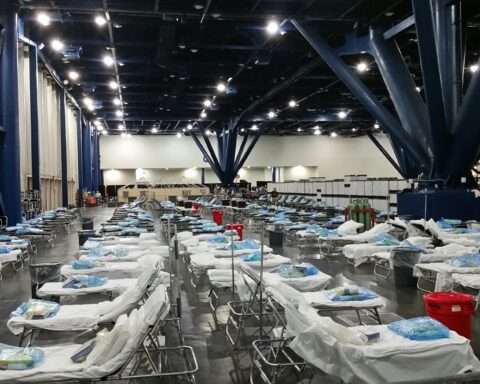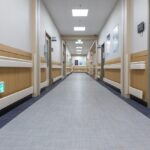In a post-pandemic world, cities are coming up with different ways to bring life back to their downtowns. Almost 20% of U.S. office space is sitting vacant, according to Moody’s, meaning it will take more than new businesses to attract people to city centers.
One strategy comes from Louisville, Kentucky, where Louisville Metro Government (LMG) and the Louisville Downtown Partnership have just released a blueprint for how to reimagine downtown over the next decade. The Louisville Downtown Development Strategy, headed by Mayor Craig Greenberg and Downtown Development Corporation chairman Ja Hillebrand, prioritizes converting vacant office space for residential and entertainment use.
The new paradigm for downtown design is in response to the way city spaces function after the pandemic. With remote work becoming more common, most employees can choose where they want to live. The development strategy takes a mixed-used approach, invigorating how Louisville incentivizes residents with a balance between living, work and play.
The driving force behind revitalizing downtown Louisville is broadening the business district into residential and attractions. LMG sees this transformation as more than aesthetic, but a “driving economic force” for a fun, safe and diverse social hub.
The strategy also identifies challenges that will need to be overcome, including staff shortages in the Louisville Metro police department, the homeless population, fewer downtown workers and reduced patronage. Although these challenges are outside the scope of the strategy, they should take precedent to ensure the realization of the plan, LMG said.
“The Louisville Downtown Development Strategy lays out a vision for what we want our downtown to be – a vibrant, thriving 24-hour neighborhood,” the office of Mayor Greenberg told Government Market News. “While Louisville’s booming tourism industry was and remains a key activity generator for our downtown, after the pandemic, it became increasingly clear that our downtown is lacking in a vital area – residents.”
Three-pronged approach
With a strong idea of how cities should adapt for the future, the development strategy lays out three pillars that prioritize and categorize their goals.
Activate downtown
While tourism has bounced back since 2020, according to city officials, the activity in downtown sectors is not evenly distributed. LMG wants to invigorate the city with attractions that will encourage activity throughout, not just in certain neighborhoods.
Their plan includes broadening downtown Louisville’s identity from just the central business district to a network of unique districts that offer their own attractions. A part of this mission is finding a way to connect the districts with walkability and an updated transportation system and expand public attractions, such as sports events and live music.
The development plan also highlights some strengths of the downtown culture that should be reinforced alongside its changes. The education corridor, which includes the University of Louisville, and the arts and culture district, which has numerous theaters, operas and museums, are both “anchors” of the city.
Reinforce downtown as a residential neighborhood
A major goal of the development plan is to increase the downtown residential population, and in turn drive the economy. To do so, there must be an established sense of community and accessible housing.
The development plan identifies a “missing middle” for housing types. Although the typical downtown apartment is readily available, duplexes, townhomes and single-family homes are harder to come by. LMG also recognizes the need for affordability to serve a wider range of residents.
Some solutions for housing diversity and affordability include infill on vacant property, converting office space into residential space and establishing neighborhoods on the edges of downtown.
Enhance the public realm
This pillar focuses on increasing the quality of downtown attractions so that it can become a place that people choose to visit and reside. This includes more pedestrian-friendly infrastructure like converting streets from one-way to two-way traffic, making the city more walkable and establishing open spaces for connectivity.
Some projects are already in the works, such as expanding Waterfront Park, redeveloping Louisville Gardens, converting several one-way streets and reimagining Belvedere, an event space on the Ohio Riverfront that the city says is currently underutilized.
“The city’s role is to provide support for these efforts, either directly through the allocation of fundings or indirectly through investments in public infrastructure and services,” the office of Mayor Greenberg said.
As a part of repurposing underutilized public-owned properties in Louisville’s downtown, the city also announced three developer partnerships to convert downtown lots. LMG chose Poe Companies, Weyland Ventures and Dallas-based Lincoln Property Company to transform the lots into affordable and market-rate housing, hospitality, arts and entertainment, distilleries, commercial spaces, grocery or mixed-use projects.
Funding for the projects is a mix of private and public investment. Government funding includes state or federal tax incentives, public infrastructure investment or direct allocations. The Kentucky General Assembly has allocated $100 million to LMG in the proposed senate budget to revitalize downtown Louisville.
“We have a number of tools that we can use to support and attract the type of projects we’d like to see in our downtown,” the office of Mayor Greenberg said. “Downtown is the heart of our city, and its success is critical to the success of our entire community. By bringing more residents downtown, investing in public safety and infrastructure, and generally making downtown a great place to live, work, and play, we will help the city grow and thrive.”








